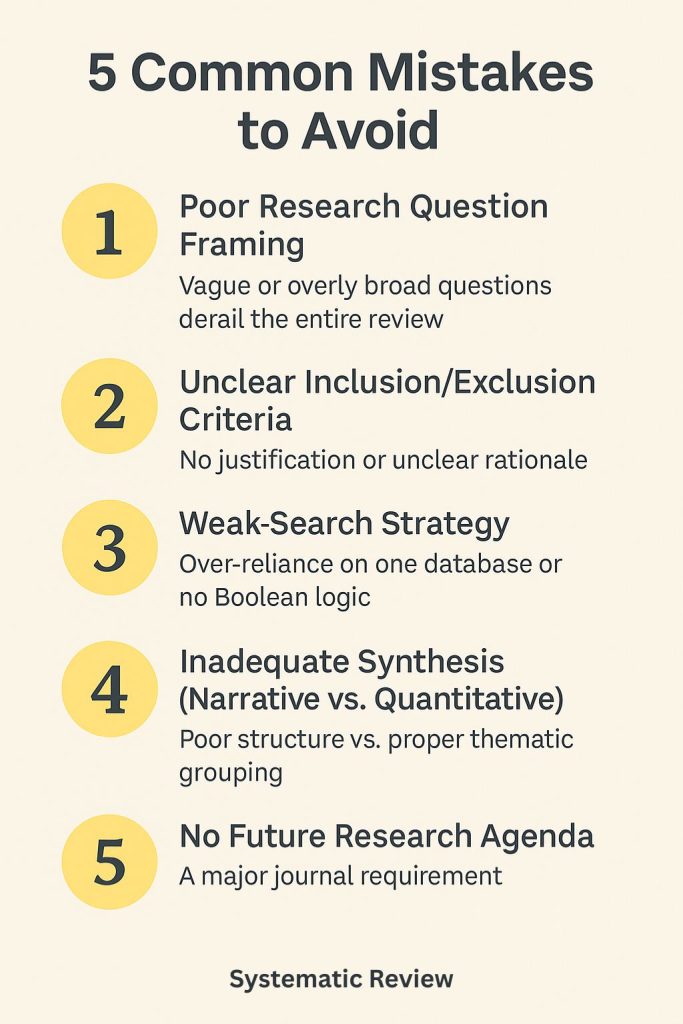Spent weeks on your systematic review, only to face desk rejection?
You’re not alone.
A well-written systematic literature review can open doors to top-tier journal publications, academic recognition, and future research opportunities. But one misstep—like a vague research question or weak synthesis—can lead to instant rejection. Editors and reviewers are quick to spot structural flaws, unclear methodologies, or missing research agendas. The truth is, even well-intentioned scholars often repeat the same avoidable mistakes.
In this post, we’ll walk you through the top 5 mistakes researchers make when writing a systematic literature review—and more importantly, how to avoid them. Plus, we’ve included a free downloadable checklist to help you self-review your draft before hitting submit.

Ready to avoid rejection and strengthen your review?
Mistake #1 – Poor Research Question Framing
Your entire systematic literature review hinges on one thing: a clearly defined research question. Get this wrong, and everything else—from your search strategy to your synthesis—can unravel.

Mistake #1 – Poor Research Question Framing
Your entire systematic literature review hinges on one thing: a clearly defined research question. Get this wrong, and everything else—from your search strategy to your synthesis—can unravel.
Vague or overly broad questions like “What is the impact of technology in education?” leave too much room for ambiguity. Without focus, your inclusion criteria become unstable, and your review turns into a scattered narrative rather than a structured analysis.
To get it right, use proven frameworks like PICOS (Population, Intervention, Comparison, Outcome, Study design) for quantitative health-based research, or SPIDER (Sample, Phenomenon of Interest, Design, Evaluation, Research type) for qualitative or mixed-methods studies. These models help narrow your scope and bring clarity to your review’s objective.
🔍 Need help refining your research question?
Give link to systematic review and meta-analysis section
❌ Mistake #2 – Unclear Inclusion/Exclusion Criteria
Imagine trying to build a house without a blueprint. That’s exactly what happens when your inclusion and exclusion criteria aren’t clearly defined in a systematic review.

Many researchers either fail to justify their criteria or make them so broad that the review loses focus and replicability. For instance, including “all studies on online learning” without specifying age group, region, or research type can dilute the review’s depth and credibility.
To avoid this, anchor your selection process to PRISMA guidelines—a gold standard that ensures transparency in how studies are identified, screened, and included. Clearly explain why certain papers were included and why others were left out. This not only strengthens the methodology but also builds reviewer confidence.
🛠 Get our team to validate your criteria before submission.
✅ Pre-Submission Peer Review (Target Journal Recommendations + AI & Plagiarism Check Reports) – USD 189 only

Mistake #3 – Weak Search Strategy A systematic review is only as strong as its search strategy. Yet many researchers fall into the trap of using just one database or skipping Boolean operators like AND, OR, and NOT. The result? A limited, biased, or incomplete pool of literature that weakens the entire review.

A weak strategy means missing out on relevant studies—and reviewers will notice.
🔍 Here are two tips to improve reproducibility and rigour:
- Use multiple databases (e.g., Scopus, PubMed, Web of Science) to ensure broad and inclusive coverage across disciplines.
- Document your exact search strings, including Boolean logic, filters, and date ranges. This allows others to replicate or validate your process—an essential feature of a high-quality systematic review.
Need help with flow diagrams? Check out this external guide:
https://docs.google.com/forms/d/e/1FAIpQLSc9_1OO6VXVQu8W_wf2vIJ5oMjfLgccxWZ5CWW66D_T1lWiMg/viewform?usp=sharing&ouid=115817654663406279148
🔗 PRISMA 2020 Flow Diagram – Cochrane
By strengthening your search foundation, you build a review that’s both credible and comprehensive.
Mistake #4 – Inadequate Synthesis (Narrative vs. Quantitative)

You’ve collected the studies—but how well do they speak to each other?
Many reviews fall apart at the synthesis stage, either by listing findings without interpretation or failing to organise insights into meaningful themes or patterns. This turns your work into a reading list rather than a valuable research tool.
A strong synthesis means more than summarising. It involves thematic grouping—comparing results, methods, and theories across studies to highlight consistencies, contradictions, and gaps.
Frameworks like TCCM (Theory, Context, Characteristics, Methodology) or ADO (Antecedents, Decisions, Outcomes) help bring structure and analytical depth to your synthesis. These models guide your categorisation process and ensure your findings tell a clear, coherent story.
💬 Need help synthesising your review into a publishable narrative?
🎯 Talk to our experts – It’s free.
Get Free Review Support
Mistake #5 – No Future Research Agenda
One of the top reasons journals reject review articles is the absence of a well-defined future research agenda. Reviewers expect more than a summary—they want to see how your work advances the field and guides future inquiry.

A strong systematic literature review doesn’t just look back; it also looks forward. It should clearly articulate where the literature is lacking and propose new directions for theory, methods, or context.
✅ A strong research agenda includes:
- Underexplored theories or frameworks that could enrich the topic
- Suggestions for alternative methodologies (e.g., longitudinal, mixed methods)
- New industry, regional, or demographic contexts where research is needed
🔍 Want to learn how to spot these gaps.

Systematic Review Pre-Submission Checklist (Free Download)
Before you hit submit, make sure your review meets these must-haves:
✔️ Is your research question clearly framed using PICOS or SPIDER?
✔️ Have you defined and justified your inclusion/exclusion criteria?
✔️ Did you search across multiple databases with documented Boolean logic?
✔️ Have you included a PRISMA flow diagram to track your study selection?
✔️ Is your synthesis organised thematically or using frameworks like TCCM/ADO?
✔️ Did you highlight consistent findings and contradictions in the literature?
✔️ Have you identified research gaps and outlined a future research agenda?
✔️ Are your tables/figures clearly structured and genuinely useful?
✔️ Did you review the article for alignment with journal standards (e.g., PRISMA, AMSTAR)?
✔️ Have you proofread for coherence, formatting, and structure?




